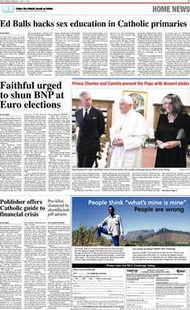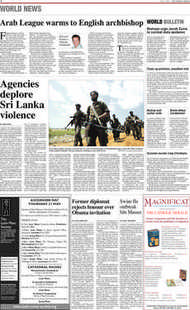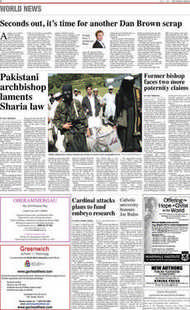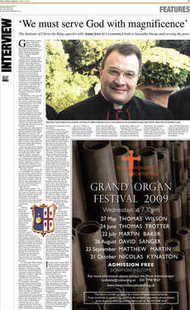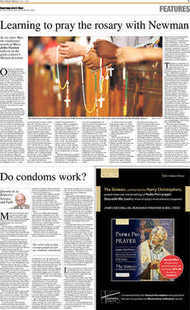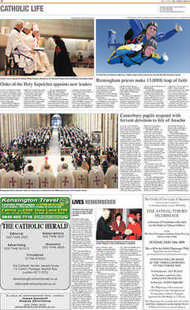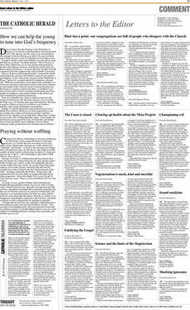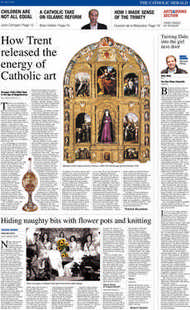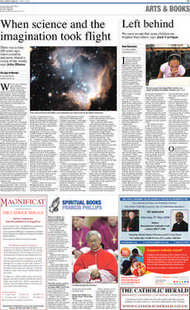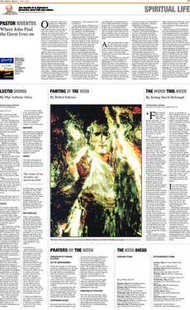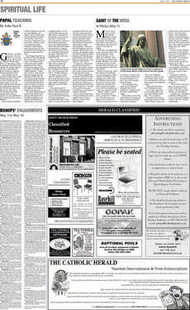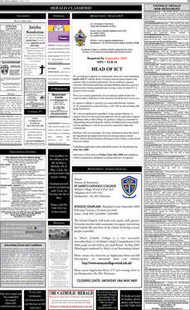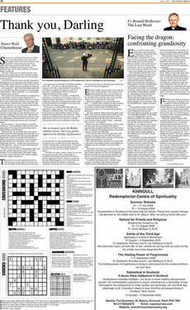Page 9, 1st May 2009
Page 9

Report an error
Noticed an error on this page?If you've noticed an error in this article please click here to report it.
Tags
Share
Related articles
I Former Coach Staging Post Has A Green Heart
Newmania : The Diet To Come, And The Oxford Work-out
Life At Littlemore The College Newman Founded
Pope Rounds Off 'year Of The Rosary' With Prayers For...
October 8, 1845 Mr. Newman Decides To Become A Catholic
Avoyage Round Cardinal Newman
Learning to pray the rosary with Newman
As we enter May, the traditional month of Mary, John Newton reflects on the great convert’s Marian devotion
One day at Littlemore, John Henry Newman was looking over some old school exercise books and found one in which he had first begun to compose Latin verses – at the age of not quite 10, the way one did in those days. “And in the first page of it there was a device which almost took my breath away with surprise,” he revealed. It was a drawing of a cross. That was quite normal for any Christian child, but next to it was a rosary, and that he could not account for. But he saw it as a sign, a prophecy, that was to be fulfilled very soon afterwards when he was received into the Church.
It is difficult to realise these days how little Protestants cared about Our Lady. During his long and anguished journey towards the faith Newman and his friends came to love her more and more, but they felt guilty about it. Right up to his conversion, Newman insisted that they must never say to her “pray for us”, but could say about her “may she pray for us”. Once across the border, and safely in the “one fold of the Redeemer”, Newman delighted to call her “Mama” and preached in her praises with joy. But he knew how difficult his friends were finding such devotion, and in some of his letters to anxious inquirers he had to reassure them that it was right to honour Our Lady. One woman, recently received into the Church, asked why she found it difficult to pray to Our Lady, and Newman wrote to say that, like any form of prayer, devotion to her is not an obligation, but it is “a gift which God gives to those whom He will”. You don’t have to force yourself to pray in a way that does not suit you, but, he went on: “I do not see how this remark applies to the rosary – and to my own feelings nothing is more delightful than the contemplation of the Mysteries of the Incarnation, under the invocation, so to call it, of her who was the human instrument of it.” Much later, in writing about the Assumption, he called Our Lady the “hidden Rose”, the “Queen of spiritual flowers; and therefore she is called the Rose, for the rose is fitly called of all flowers the most beautiful”.
Newman discovered meditation some time before he became a Catholic, and he tried to teach his parishioners to meditate. “What is meditating on Christ?” he asked. “It is simply this, thinking habitually and constantly of Him and of His deeds and sufferings. It is to have Him before our minds as One whom we may contemplate, worship, and address when we rise up, when we lie down, when we eat and drink, when we are at home and abroad, when we are working, or walking, or at rest, when we are alone, and again when we are in company, this is meditating.” Newman did seem to confuse meditation with contemplation a little (and he could never be described as a “contemplative”), but what he means is that we can use our imagination, our memory and our intelligence to think about Jesus Christ. Newman would have followed the usual procedure of choosing a Gospel text and imagining the scene before his eyes. The rosary is a succession of meditations on the birth, death and resurrection of Our Lord, in the presence of Mary, or “under her invocation” as he put it. As the scenes pass before our eyes, she is there to share our view of them, and to point out what is happening in those great moments of our salvation, with which she was so intimately linked. The words of the prayers are a background rhythm to accompany the work of the mind. In modern terms we might think of the rosary as “watch with Mother”. It is a prayer that can be used in many different ways, and many different places – including while working or walking and alone or in company.
That is why the Oxford Oratory has prepared a recording of the rosary. We at the Oratory consider Newman our real founder, so we chose a meditation from Cardinal Newman to go before each Mystery. Newman did not write much about prayer, and his collected Meditations and Devotions were only published after his death from papers found in his room. Among them is a set of meditations designed to be read out in Church during the May devotions, using the Litany of Loreto. It was among these texts that we found many of the meditations for the rosary, although we had to fill some gaps by looking through his published sermons, including many of the later Anglican ones. In that way we present a short text for each Mystery, to give us a glimpse of Newman’s spirituality and to help us penetrate deeper into the meaning of the events we see before us.
Since the recording is to be sold to raise funds for Aid to the Church in Need (ACN), we also included short passages from the writings of Fr Werenfried, the famous “bacon priest” who began ACN by persuading his Dutch neighbours to help suffering priests in the Russian zone of Germany. ACN has since expanded its work worldwide and provides assistance to churches, seminaries, convents and religious houses wherever it is needed. Recently a significant grant went to the Oratory at Oudtshoorn in South Africa, to begin the construction of a chapel for township children.
The Oratory community in Oxford offers this recording of the rosary to consolidate our links with the Church overseas, and with all Mary’s children everywhere.
Representative parishioners of the Oxford Oratory Church read the passages from Fr Werenfried and introduced the 15 mysteries of the traditional rosary; one is from West Africa, one from India, one from Australia and one from central Europe; the Newman meditations were selected by one of our South African students, and read by a local Oxford boy now training as an actor. The “chorus” included three sisters who had just come back from World Youth Day in Sydney; the priest leading the prayers had been ordained just two months before the recording was made. One of the Oratory Fathers, two Dominicans and a student provided plainsong pieces between each set of Mysteries. The Oratory choirmaster played an accompaniment to the recitation of the Hail Marys.
We had hoped to include a few more items, but we ran out of time: the CD is 78 minutes, which is as long as can be made. On the cover we put the statue of Our Lady from the Oratory church and a rosary which had once belonged to Newman himself, now in the care of the sisters at Littlemore. A few views of the church, which is in the process of restoration, are included in the booklet.
John Newton works for Aid to the Church in Need UK. The CD, Praying the Rosary with Cardinal Newman, is available directly from Aid to the Church in Need, or through various church bookstalls, priced £11.50
blog comments powered by Disqus




